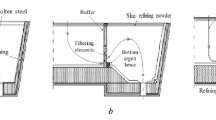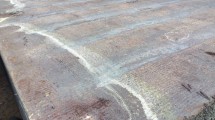Abstract
Production of slabs for sour service applications requires stringent control in slab internal quality and secondary processing so as to guarantee resistance against hydrogen-induced cracking (HIC). ArcelorMittal Steelmaking facility at Lazaro Cardenas, Mexico had recently implemented key steelmaking and casting processing technologies for production of sound, centerline free slabs for catering to the growing API Linepipe and off-shore market for sour service applications. State-of-the-art steelmaking with use of residual-free Direct-reduced Iron and continuous casting facilities with dynamic soft reduction were introduced for the production of slabs with ultra clean centerline. Introduction of controlled cooling of slabs for atomic hydrogen control well below 2 ppm has enabled production of slabs suitable for excellent HIC-resistant plate processing. Substantial tonnages of slabs were produced for production of API X52-X65 grade plates and pipes for sour service. Stringent quality control at each stage of steelmaking, casting, and slab inspection ensured slabs with excellent internal quality suitable for HIC resistance to be guaranteed in final product (Plates & Pipes). Details of production steps which resulted in successful HIC-resistant slab production have been described in this article.









Similar content being viewed by others
References
C.G. Interrante, Current Solutions to Hydrogen Problems in Steel, C.G. Interrante, G.M. Pressoure, Eds., ASM, OH, 1982, p 3
A.G. Quarrell, Hydrogen in Steel, Symposium on Production, Properties and Applications of Alloy and Special Steels, NML Jamshedpur, 1956, p 256
A.R. Troiano, Keynote Lecture, Hydrogen in Metals, I.M. Bernstein and W. Thompson, Eds., ASM, 1973, p 3
C.A. Zapffee, Iron-hydrogen Binary Diagram, Metals Handbook, ASM, Metals Park, OH, 1948, p 1208
Y. Tomita, T. Kikutake, K. Nagahiro, K. Okamoto, and H Nakao, Hydrogen Problems in Steels, Proceedings of the First International Conference, C.G. Interrante and G.M. Pressoure, Eds., ASM, OH, 1982, p 63
D.G. Stalheim and B. Hoh, Guidelines for Production of API Pipelines Steels Suitable for Hydrogen Induced Cracking (HIC) Service Applications, Proceedings of IPC 2010, 8th International Pipeline Conference, Alberta, Canada, 2010
A.K. De, Microstructural Analysis of X70 plate samples, ArcelorMittal USA R&D Internal Report, 2009
Mannesmann Rating System for Internal Defects in CC Slabs: April 2001, PTS, Germany.
H.T. Tsai and R. Torres, Third International Conference on Continuous Casting of Steel in Developing Countries, Vol 39, Beijing, 2004, p 54
Sour Gas Resistant Pipe Steel, Niobium Information, 18/01
A. Ghosh, Segregation in Cast Products, Vol 26, Sadhana, 2001, p 5
K. Hulka and J.M. Gray, High Temperature Processing of Line Pipe Steels, Niobium Science and Technology, Proceedings of the International Symposium Niobium 2001, TMS, Orlando, 2001, p 587
D.M. Humes, Dynamic Soft Reduction of Continuously Cast Slabs, Iron and Steel Technology, 2008, p 29
J. Nieto, T. Elias, J.C.D. Pureco, B. Emling, D. Humes, and J. Lauglin, Optimization of Dynamic Soft Reduction of Continuously Cast Slabs, Proceedings of 4th Congress of National Steelmaking Conference, AIST Mexico, Monterrey, 2010
H. Lachmund, V. Schwinn, and H.A. Jungblut, Heavy Plate Production: Demand on Hydrogen Control, Ironmaking Steelmaking, 2000, 27, p 381
J.D. Hobson, The Diffusion of Hydrogen in Steel at Temperatures of −78 to 200 °C, JSIS, 1958, 189, p 315
E.W. Johnson and M.L. Hill, The Diffusivity of Hydrogen in Alpha Iron, Trans. AIME, 1960, 218, p 1104
“NACE Standard TM 0284-96”, Evaluation of Pipeline and Pressure Vessel Steels for Resistance to Hydrogen-induced Cracking, NACE, Houston, TX, USA, 1996.
"NACE Standard TM0177-96", Laboratory Testing of Metals for Resistance to Sulfide Stress Cracking and Stress Corossion Cracking in H 2 S Environments, NACE, Houston, TX, USA, 1996.
Acknowledgments
The authors sincerely acknowledge the support and continuous encouragement of the AMLC management and AM Global R&D, E Chicago during the entire development process and for permission to publish this article. The technical support provided by Dan Kruse, AM Global R&D and contribution from Arijeet Sengupta and Manjunath Raghavelu, AM International is sincerely acknowledged.
Author information
Authors and Affiliations
Corresponding author
Additional information
This paper is based on AIST 2013 Richard J Fruehan Award for Best Paper.
Rights and permissions
About this article
Cite this article
Nieto, J., Elías, T., López, G. et al. Effective Process Design for the Production of HIC-Resistant Linepipe Steels. J. of Materi Eng and Perform 22, 2493–2499 (2013). https://doi.org/10.1007/s11665-013-0544-9
Received:
Revised:
Published:
Issue Date:
DOI: https://doi.org/10.1007/s11665-013-0544-9




